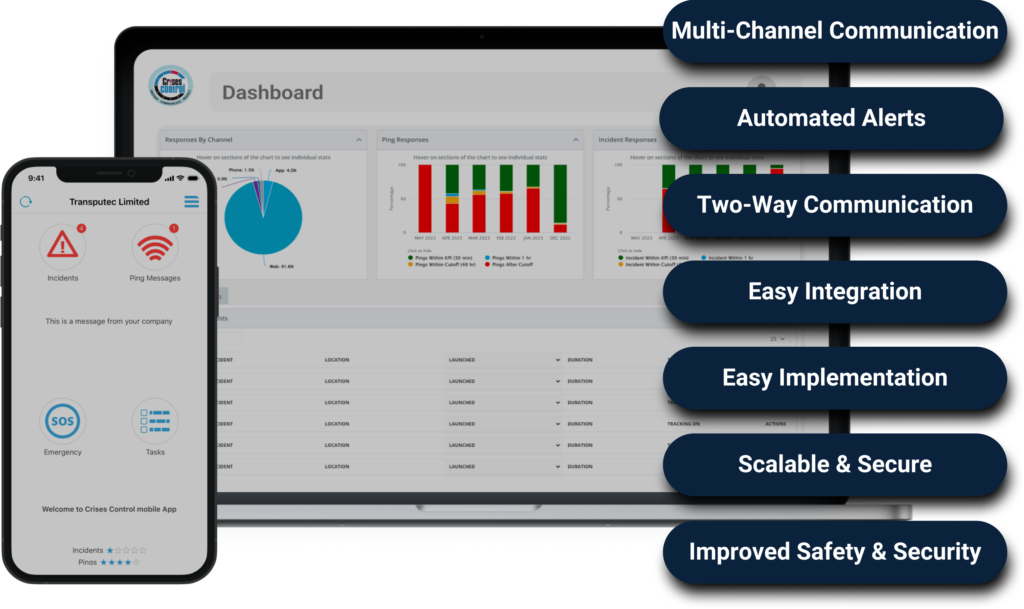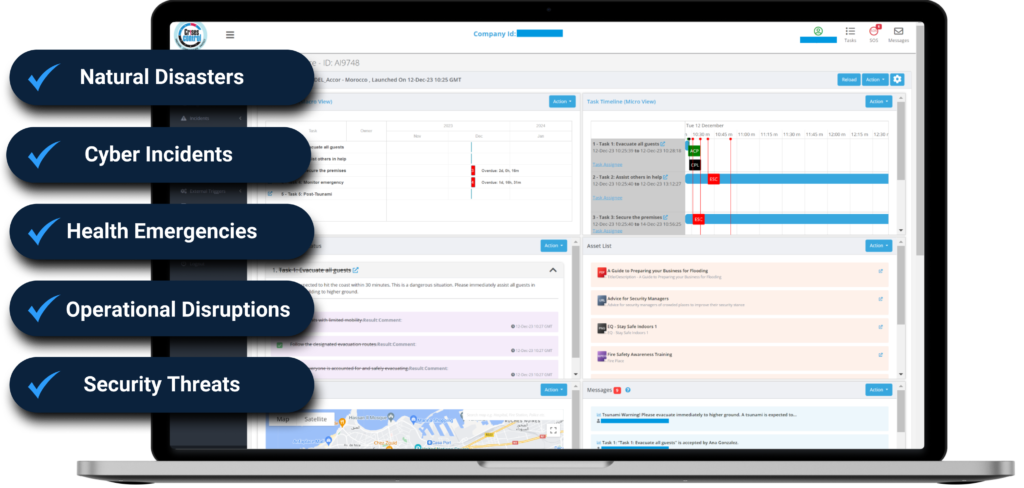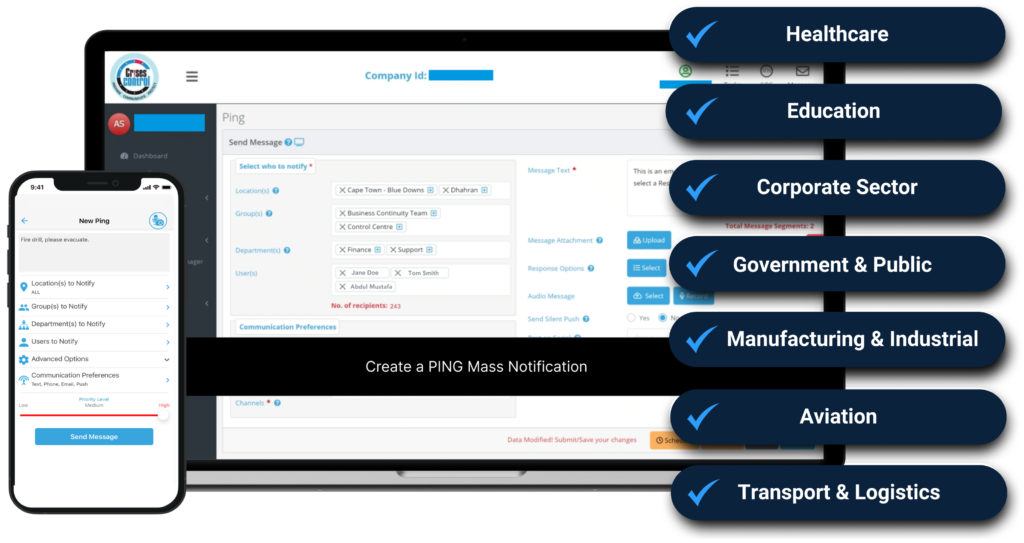Written by Anneri Fourie | Marketing Executive
In today’s unpredictable world, the ability to respond swiftly and efficiently to crises can make the difference between survival and disaster for organisations. Emergency communication solutions play a pivotal role in this context, providing robust platforms to manage crises and ensure business continuity.
In this blog, we will explore what emergency communication solutions are, their benefits, the types of crises they can address, the industries that can benefit from them, and how to effectively use them. Additionally, we will delve into how Crises Control can be your trusted partner in navigating emergencies.
What Are Emergency Communication Solutions?
Emergency communication solutions are comprehensive systems designed to facilitate swift, effective, and coordinated responses during emergencies. These solutions encompass a range of tools and technologies that enable organisations to communicate critical information to their stakeholders, including employees, customers, and partners, in real-time. The core components typically include mass notification systems, two-way communication platforms, and integrated alert systems.
Emergency communication software is a subset of these solutions, focusing on the technological infrastructure that supports seamless information dissemination and response coordination. These platforms often come with features like automated alerts, multi-channel communication options (such as SMS, email, voice calls, and push notifications), and real-time tracking of message delivery and responses.
Benefits of Emergency Communication Solutions for Organisations

Implementing emergency communication solutions offers numerous advantages for organisations, enhancing their resilience and operational effectiveness during crises.
Rapid and Reliable Information Dissemination
One of the primary benefits is the ability to quickly disseminate accurate information to all relevant parties. In a crisis, time is of the essence, and delays can exacerbate the situation. With robust emergency communication solutions, organisations can send out alerts and updates instantaneously, ensuring everyone is informed and can act accordingly.
Enhanced Coordination and Collaboration
Effective emergency communication software facilitates better coordination among response teams and stakeholders. Features like two-way communication and real-time updates allow for dynamic response strategies, enabling teams to adjust plans based on evolving circumstances. This level of collaboration is crucial for managing complex crises.
Improved Safety and Security
By ensuring that all stakeholders receive timely warnings and instructions, emergency communication solutions significantly enhance safety and security. Whether it’s an evacuation order during a natural disaster or instructions during a cyberattack, these solutions help protect lives and assets.
Business Continuity and Reputation Management
Maintaining operations during a crisis is vital for any organisation. Effective communication helps minimise downtime and ensures that critical functions continue, supporting business continuity. Moreover, transparent and timely communication can preserve an organisation’s reputation, demonstrating competence and care during emergencies.
Types of Crises Addressed by Emergency Communication Solutions

Emergency communication solutions are versatile and can be tailored to address various types of crises, including:
Natural Disasters
Earthquakes, hurricanes, floods, and other natural disasters require immediate and coordinated responses. Emergency communication systems can issue warnings, provide safety instructions, and keep everyone updated on the situation.
Technological and Cyber Incidents
In the event of a cyberattack, data breach, or other technological failure, swift communication is crucial to mitigate damage. These solutions help in notifying affected parties, coordinating IT responses, and managing public relations.
Health Emergencies
Pandemics, disease outbreaks, and other health-related crises necessitate precise and continuous communication. Emergency communication software can disseminate health guidelines, track health status, and manage quarantine protocols effectively.
Operational Disruptions
Situations like power outages, supply chain disruptions, and other operational challenges can be managed efficiently with these solutions. They ensure that all stakeholders are informed about the status and contingency plans, reducing confusion and downtime.
Security Threats
Terrorist attacks, active shooter situations, and other security threats require immediate action. Emergency communication systems can provide real-time alerts, safety instructions, and coordination among security personnel and law enforcement.
Industries That Benefit from Emergency Communication Solutions

Emergency communication solutions are not one-size-fits-all; they can be customised to meet the specific needs of various industries. Here are some sectors that can significantly benefit:
Healthcare
Hospitals and healthcare facilities need reliable communication systems to manage patient care, coordinate with emergency services, and maintain operational continuity during crises. Emergency communication software can streamline these processes and ensure patient safety.
Education
Schools and universities must be prepared for a range of emergencies, from natural disasters to security threats. Effective communication ensures the safety of students, faculty, and staff, and facilitates coordinated responses.
Corporate Sector
Businesses of all sizes require robust communication strategies to manage operational disruptions, cyber incidents, and other emergencies. These solutions help maintain business continuity and protect organisational assets.
Government and Public Sector
Government agencies and public sector organisations are often on the front lines during crises. Effective communication is critical for public safety, resource allocation, and inter-agency coordination.
Manufacturing and Industrial Industry
Industrial facilities face unique risks, including equipment failures and hazardous material incidents. Emergency communication systems help manage these risks by providing timely alerts and coordinating response efforts.
Aviation
The aviation industry requires stringent communication protocols to ensure passenger safety and operational efficiency. Emergency communication solutions help manage various crises, including technical failures, severe weather conditions, and security threats. These systems ensure that all personnel, from ground staff to air traffic control and flight crews, are informed and can respond appropriately to any situation.
Transport and Logistics
In the logistics industry, timely communication is critical for managing supply chain disruptions, transportation delays, and safety incidents. Emergency communication solutions enable logistics companies to quickly relay information about delays, reroute shipments, and coordinate with partners and clients to minimise impact. This helps maintain the flow of goods and ensures customer satisfaction even during emergencies.
Example of How to Use Emergency Communication Solutions
Consider a scenario where a multinational corporation faces a significant cyberattack. Here’s how an emergency communication solution can be used effectively:
- Initial Alert: As soon as the IT team detects the breach, an automated alert is sent to the crisis management team via SMS, email, and push notifications.
- Incident Assessment: The team uses the communication platform to conduct a quick assessment and determine the severity of the attack.
- Stakeholder Notification: Alerts are sent to all employees, instructing them on immediate actions to secure data and avoid further breaches. Notifications are also sent to clients and partners, informing them of the situation and measures being taken.
- Coordination: The IT team collaborates with external cybersecurity experts through the communication platform, sharing real-time updates and coordinating response strategies.
- Resolution and Follow-Up: Once the breach is contained, a detailed report is sent to all stakeholders, and follow-up communications ensure that preventive measures are understood and implemented.
This example demonstrates the critical role of emergency communication solutions in managing complex crises and maintaining organisational resilience.
How Crises Control Can Help
Crises Control offers award-winning emergency communication solutions designed to meet the unique needs of diverse organisations. Our platform provides:
Comprehensive Communication Tools
Crises Control includes mass notification systems, two-way communication, and real-time tracking, ensuring that all stakeholders receive timely and accurate information.
Customisable Solutions
Our emergency communication software is highly customisable, allowing organisations to tailor it to their specific needs and industry requirements.
User-Friendly Interface
Designed with ease of use in mind, our platform ensures that even non-technical users can effectively manage and respond to crises.
24/7 Support
Our dedicated support team is available around the clock to assist with any issues and ensure that your organisation remains prepared for any emergency.
Robust Analytics and Reporting
Crises Control provides detailed analytics and reporting tools to help organisations evaluate their response strategies and improve future performance.
Conclusion: Stay Prepared with Crises Control
In an unpredictable world, having reliable emergency communication solutions is essential for organisational resilience. Whether dealing with natural disasters, cyber incidents, or other crises, effective communication can safeguard lives, protect assets, and ensure business continuity. Crises Control offers cutting-edge solutions to help you stay prepared and respond efficiently to any emergency.
Don’t wait for a crisis to strike. Contact us today to get a free personalised demo of our emergency communication software and see how we can help you ensure your organisation’s safety and resilience.
Request a FREE Demo

FAQs
1. Are emergency communication solutions complex to set up and use?
2. How can emergency communication solutions be customised for my industry?
3. What types of alerts can be sent through emergency communication solutions?
4. How does emergency communication solutions improve an organisation’s response time during a crisis?
5. What are the benefits of using Crises Control’s emergency communication solutions?
– Customisation
– 24/7 Support
– Actionable Insights
– Crisis War Gaming and Tabletop Exercises
– A Free Personalised Demo








